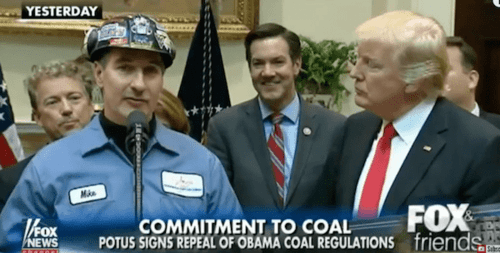
07/18/2017
It was a sweet early moment in the Trump Presidency: a group of miners had been invited to the White House to watch the new Chief Executive end Obama regulations that were designed to cripple the coal industry.Nelson appeared later on Fox News to discuss how he hoped for better times in coal country. “For a politician to such as Donald Trump to stand up and hold good to his promise is absolutely fantastic, and he’s an inspiration to all working Americans,” he remarked.
I wondered at the time whether the miners knew that automation posed a bigger long term threat than even business-buster Obama.
Miners have already been threatened by immigrants workers willing to perform the tasks more cheaply, as I wrote a decade ago in American Miners Now Targeted. Mine executives wanted to scrap the English-only policy, which would have further endangered worker safety in a dangerous workplace.
Now the machines are here, and even the smartest ones don’t worry about survival — yet.
Bloomberg reported March 27 in Trump’s Executive Order Won’t Save Coal Mining Jobs that the industry has changed quite a bit:
… The image of miners toiling underground is increasingly antiquated, as companies use automated tools to extract coal from giant seams in the Powder River Basin in Wyoming and Montana. There, electric shovels are able to claw 400 tons worth of coal at a single time from open pits, and load them up onto rail cars bound for plants as far away as Georgia.A recent recent article from an industry pub was a reminder of the automation pressure on mining:As a result, total U.S. coal employment plunged to 53,000 last year; in the 1940s, West Virginia alone was home to 126,000 miners …
Robots and recruitment: the impact of automation on mining jobs, Mining-Technology.com, July 13, 23017Translation of that last bit: there will be a computer operator in an office running the machines that do the extraction, similar to the way the oil business is going: New York Times Reports Automation-Fueled Job Loss in the Oil Patch… The job drain of recent years, felt across the mining sector globally, can be attributed in part to automation, which has made the profession significantly safer.
‘Smart’ mines, which incorporate everything from drones and wearables to 3D printing, are becoming more commonplace, and recruitment and human resources have simply not kept pace with the growth of technology. But there is hope.
“The message is that it’s not necessarily fewer jobs in mining — it will just be different jobs,” says Philip Hopwood, Deloitte global head of mining. “In reality,” he adds, “employment will be growing in the mining sector as we see mining investment ramp back up again, leading to opportunities in jobs related to investment in building what we term the digital mine.”
At present, Hopwood says the mining sector is still playing catch-up with the likes of real-time data analytics and the phasing out of manual labour in favour of the back office, whereby on-site technology is connected to back-end systems. The next step for miners is to find the right talent to operate the tech.
This is a content archive of VDARE.com, which Letitia James forced off of the Internet using lawfare.